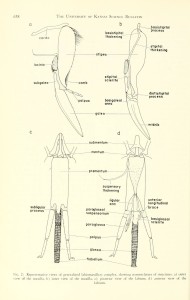At one point early in my career I was recognized as the world’s expert in the labiomaxillary complex of the long-tongued bees, at least among the half-dozen or so entomologists for whom bee mouthparts mattered.
I achieved this obscure recognition as a graduate student at the University of Kansas by dissecting, drawing and analyzing mouthparts from about 100 species across the thousands that make up this diverse bee group. The other bees have short tongues and were studied by another student, who ascended to the short-tongued throne. Tongue length makes a difference to bees, as it determines what flowers they can collect nectar from.
Admittedly obscure, and not generally seen as among my most stellar achievements, this study nevertheless transformed by scientific career, not so much for the scientific findings as for the cultural lessons I learned from my mentor in the project, the eminent bee biologist Charles Michener.
Mich was a prodigy, publishing his first paper on bees when he was 16 and going on to reach the highest levels of academia. In 1948 he had published a paper describing the evolutionary relationships between all the bees, a monumental achievement that formed the bible of bee taxonomy for decades.
What changed everything for me was the basistipital process, a tiny obscure protuberance found on some long-tongued mouthparts but not on others. What made this structure important was that it differed in the highly social honeybees and stingless bees. Tracing its evolution back through more primitive bees suggested that each group had evolved social behavior independently.
If so, this was a career-building discovery, as the evolution of complex social behavior is rare. The key implication of this finding was that sociality had evolved not once but twice among the bees.
Studies of insect social behavior were and still are important areas of research, in part because we too are a highly social species and can learn much about our own evolution and behavior by examining that of the bees.
I quickly realized the important implications of the basistipital process, but my next thought was more terror than exhilaration. If I was right, then Mich’s classic study was incorrect. I would have to tell one of the greatest biologists of our time that he was wrong.
It was with great trepidation, and after considerable procrastination, that I made an appointment to see Mich and brought him my findings. I was well prepared with specimens and my arguments, but was surprised by his reaction.
Mich was fascinated rather than defensive. Without the slightest sign of disappointment he said we needed to reexamine the honeybees and stingless bees to see if other evidence would support changing his 1948 conclusions.
We went on to look at other structures, particularly those on the legs used to collect pollen, and a wide range of social behaviors in the two groups. The evidence was strong, and we published a paper in the prestigious Proceedings of the U.S. National Academy of Science (PNAS) proposing the dual origin of highly social behavior among the bees.
I’m a big appreciator of how moments in life can have lasting impact. That appointment with Mich was one of those moments for me, when he was open to contradicting his own classic and much-cited work if the evidence supported it. He modeled for me how science is not a right or wrong polarity but a continually evolving examination of new data. When the data contradict the theory, it’s appropriate to dump even the most hallowed hypothesis.
I also learned from Mich to appreciate those moments of surprise in science when the evidence suggests the hypothesis you have based years of work on is wrong. My own students have been startled expecting me to be disappointed that their experiments have not proven my pet theory to be correct, and I treat their negative data as a eureka moment. It’s in the negative results that progress in science is born.
I learned one more lesson from Mich through the humble basistipital process. He let me write and be the first author on the PNAS paper, even though this was an important publication, I was an obscure student and he was, well, the Great One in bees. I still choke up recalling this incredible kindness, and hope I have emulated his generosity with my own students.
And there is a postscript: about ten years later new molecular techniques became available that allowed comparisons of proteins and even genes between groups of organisms. When applied to the long-tongued bees, the results suggested that Michener’s original taxonomy was correct, and our dual origin proposal perhaps was not accurate. It remains an ongoing issue in social insect biology, with no definitive conclusion yet possible.
My response? I would love to be proven incorrect.
Science at its best is not about ego but about exploration. I was fortunate to be taught that lesson by the mouthparts of the long-tongued bees, and a wonderful mentor.
For excruciating detail see:
Winston, M.L. and C.D. Michener. 1977. Dual origin of highly social behavior among bees. Proc. Natl. Acad. Sci. 74: 1134-1137
Winston, M.L. 1979. The labiomaxillary complex of the long-tongued bees: a comparative study. Univ. Kansas Sci. Bull. 51: 631-667
